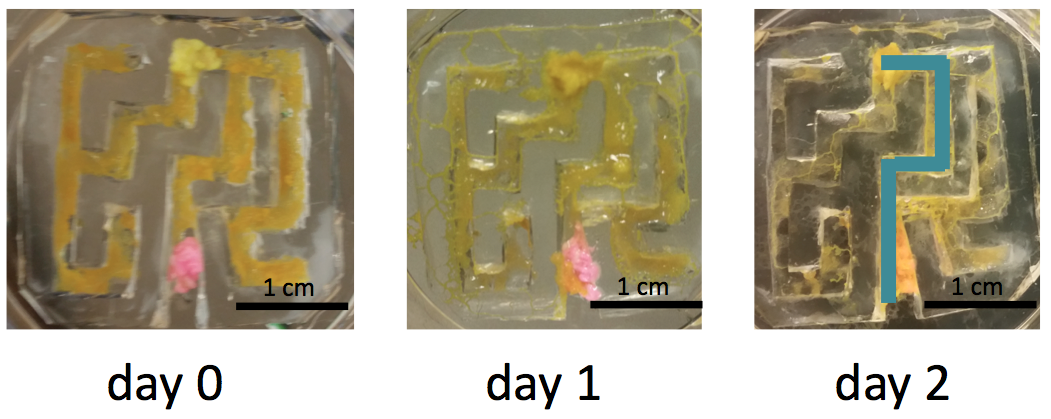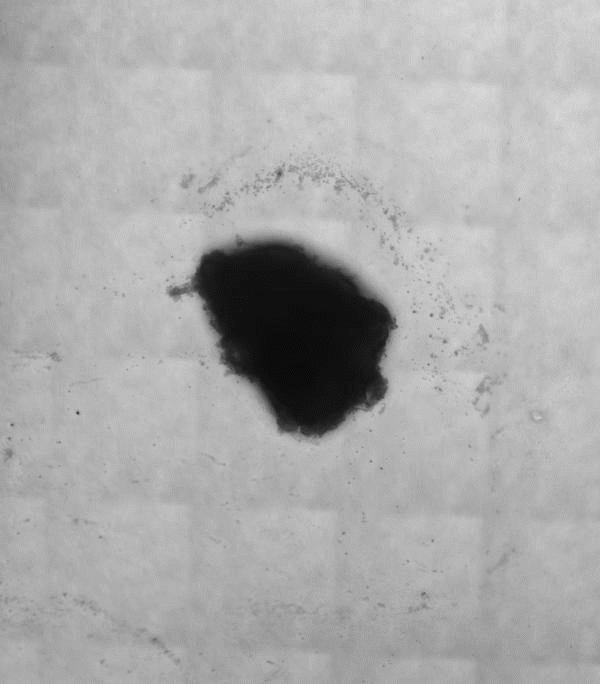How Can a Slime Mold Solve a Maze? The Physiology Course is Finding Out

The slime mold doesn’t have a brain, but it can solve a maze. Wallace Marshall, co-director of the MBL Physiology course, first introduced the single-celled slime mold Physarum polycephalum to the course last year.
“There’s been a lot of [information] on the web about Physarum [solving mazes] but there’s still lot of experimental science to be done, especially at the cellular level, which is the course’s specialty,” says Marshall, a professor at University of California, San Francisco.
When placed in a maze containing food at one end, Physarum can branch into every nook and cranny and solve the maze. Once it finds the food, the branches that did not locate food retract, leaving behind a trail of slime. This slime serves as a signal telling the mold not to go in that direction in the future.
 Physarum finds shortest path between two food sources (yellow and pink) in the maze. Image credit: Yang Joon Kim.
Physarum finds shortest path between two food sources (yellow and pink) in the maze. Image credit: Yang Joon Kim.Physarum is also able to identify the shortest path between sources of food. Marshall thinks that Physarum does this by measuring the length of its branches. “Physarum is like a network of tubes and the cytoplasm is flowing in these tubes,” Marshall says. Protein rings contract around the branches to push their intracellular contents, and the longer the branch, the more the resistance. Marshall thinks Physarum uses flow rates and resistance to gauge branch length.
By bringing together a diverse set of skills, five students in the MBL Physiology course (George Bell, Yang Joon Kim, Deepak Krishnamurthy, Elizabeth Mueller, and Shahrzad Yazdi) are tackling questions in Physarum cell biology and information transfer. Krishnamurthy says, “We have this big question that we are all taking different parts of: How does this organism form the shapes that you see? How do they function?”
A Physarum cell starts growing as an undefined blob. Eventually it starts branching out in a seemingly random fashion. Bell, Mueller, and Yazdi are studying Phsysarum branching initiation and how the cell’s structural components are involved. By observing how Physarum transforms into an elaborate network of branches in different environments, the students hope to learn about the triggers for branching at a macroscopic level.

To zoom in even closer on what’s happening within the branches, the student turned to the slime mold’s favorite food: oatmeal. When oatmeal is combined with fluorescent beads, the slime mold glows after it ingests the mixture. This allows the students to visualize movement inside Physarum branches. Krishnamurthy and Kim are watching the fluorescent beads flow within the cytoplasm which can tell them how information is spatially transferred within the Physarum cell.
Fluorescent beads can also help them ask more complex questions. If beads with different colors are used, the flow of information from multiple sources can be monitored at the same time. Kim is interested in seeing how information flows if there are two food sources; whether slime molds can recognize self versus non-self; and if they will solve mazes cooperatively.
While watching a mold without a brain solve a maze is intrinsically remarkable, we are just at the beginning of understanding this primitive sensory system.